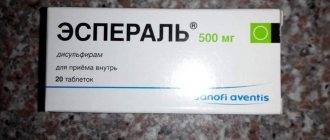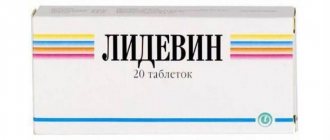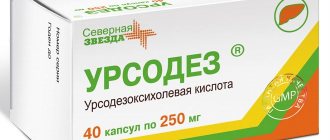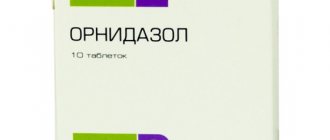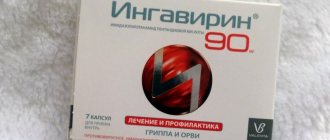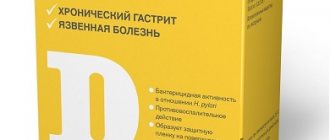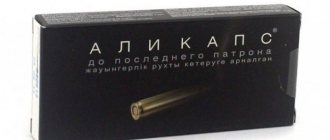Pharmacological properties of the drug Disulfiram
A specific remedy for the treatment of chronic alcoholism. The effect of disulfiram is due to its ability to disrupt the metabolism of alcohol. In the body, disulfiram is converted into N,N-diethyldithiocarbamic acid and other metabolites that block metal ions and sulfhydryl groups of enzymes involved in the neutralization of alcohol. Ethanol in the body undergoes oxidative transformations through the phase of acetaldehyde and acetic acid (under the influence of acetaldehydroxydase, acetaldehyde is quickly oxidized). By blocking the enzymatic biotransformation of alcohol by alcohol dehydrogenase, disulfiram promotes the accumulation of acetaldehyde in the blood after drinking alcohol with the development of characteristic toxic effects (nausea, vomiting, skin flushing, a feeling of heat in the face and upper body, chest pain, difficulty breathing, noise in the head, palpitations, dizziness, feeling of fear, chills, decreased blood pressure, etc.). Prescribing alcohol against the background of the action of disulfiram allows you to develop a persistent negative conditioned reflex to the taste and smell of alcohol and, with long-term treatment, achieve partial or complete intolerance to alcohol. After oral administration, it is quickly, but not completely (70–90%) absorbed from the digestive tract. The duration of action when taken orally is 48 hours. Disulfiram is rapidly metabolized by reduction into diethyldithiocarbamate, which is released in the form of conjugates, or into diethylamine and carbon disulfide (from 4 to 53%). The latter is excreted through the lungs. After implantation of a sterile tablet, disulfiram gradually diffuses into the blood, creating a stable concentration of at least 20 ng/ml. In adult patients, a dose of 0.25 g is administered intramuscularly (slowly over 30–60 s) deep into the upper outer quadrant of the gluteal muscle. Depending on the severity of the disease, the patient’s character, and the frequency of relapses, the annual course of treatment is up to 10–12 injections. The appearance of pathological craving for alcohol in the remission phase is the main criterion for urgent re-introduction of disulfiram in order to maintain long-term therapeutic remission.
Side effects
The drug belongs to the category of low toxicity, but in a number of exceptions side effects may appear:
- metallic taste in the mouth;
- loss of orientation in space;
- anaphylaxis;
- body odor changes;
- headache;
- inflammatory processes in the nervous tissues of the extremities;
- neurological disorders.
The consequences of drinking alcohol and Disulfiram for the patient are very serious. In fact, this is a many times stronger hangover, accompanied by a negative effect on most organs and systems of the body.
After drinking alcohol, a person under the influence of this drug experiences severe vomiting, nausea, and headache. In addition, he suffers from:
- bradycardia and tachycardia;
- loss of orientation in space;
- seizures;
- collapse;
- lack of air and shortness of breath.
In some cases, a heart attack may occur, then a person’s life will be in danger.
If a coded patient has consumed alcohol, it is necessary to take urgent measures to stabilize his condition. He is placed in a clinic under the supervision of medical workers. When using Disulfiram, it is necessary to completely eliminate alcohol from the diet. To trigger the reaction, 50 ml of an alcoholic drink is enough.
If the patient's condition worsens significantly, surgical intervention begins. With its help, the implant is removed. After decoding, detoxification measures are carried out.
Use of the drug Disulfiram
Adults inside. Optimal doses are 0.25–0.5 g/day; at doses below 0.15 g/day, disulfiram does not cause the desired effect. The usual treatment regimen is as follows: the first disulfiram-alcohol test is carried out 7–10 days from the start of treatment (after taking disulfiram in the morning at a dose of 0.5–0.75 g, the patient drinks 20–30 ml of 40% ethyl alcohol or vodka, or other alcohol drink. Repeated tests in a hospital setting - after 1-2 days, in an outpatient setting - after 3-5 days. If the reaction is weak, the dose of alcohol during subsequent tests is increased by 10-20 ml. Maximum dose - 100-120 ml of 40% ethanol . The use of the implantation method is most rational after a course of detoxification. In compliance with all the requirements of asepsis and antisepsis, under local anesthesia, a small incision (approximately 6 mm) is made in the left iliac region, low enough to avoid friction with the belt. The subcutaneous tissue is spread apart and crosswise using a trocar 2 sterile tablets are implanted at 4 points around the incision to a depth of approximately 4 cm. A suture with a sterile bandage is placed on the incision.
Cost of treatment
The cost of using Disulfiram is discussed individually. This depends on the chosen coding method, as well as on the duration of the drug.
The final cost is influenced by the number of medical services that were performed before coding. The patient may require withdrawal from binge drinking and a course of treatment for concomitant diseases that have developed or worsened due to alcohol dependence. In some cases, there is a need for professional psychological help or rehabilitation.
The rehabilitation center has developed several programs for patients with different income levels. Coding is not a solution to all problems; you should complete a full course, including rehabilitation and social adaptation.
Contraindications to the use of the drug Disulfiram
Absolute - endocrine diseases (thyrotoxicosis, diabetes mellitus), severe cardiosclerosis, cerebral vascular atherosclerosis, coronary artery disease, stage II–III hypertension, severe vascular diseases, pulmonary tuberculosis with hemoptysis, recent tuberculous infiltrate, asthma, severe pulmonary emphysema, bleeding gastric ulcer , severe liver and kidney diseases, hematopoietic disorders, mental illness, central nervous system infections, epilepsy and epileptiform syndrome, polyneuritis, neuritis of the auditory and optic nerves, glaucoma, malignant tumors, pregnancy, hypersensitivity to disulfiram. Relative contraindications are residual effects after organic brain damage, age over 60 years, endarteritis, peptic ulcer of the stomach and duodenum, residual effects after central nervous system infections and stroke, previous disulfiram psychosis.
Antidote for Disulfiram
There is no substance that can remove Disulfiram from the body. Sometimes ascorbic acid or iron preparations are used as an antidote, but they are useless. A person who has decided to undergo treatment needs to know that decoding from Disulfiram is impossible. The medicine will act for the period of time specified by the doctor. This is due to the fact that, due to its high solubility in lipids, disulfiram accumulates in fatty tissue, from where it enters the bloodstream in small doses to constantly maintain the desired concentration of the drug.
Special instructions for the use of the drug Disulfiram
The use of disulfiram can be accompanied by significant side effects, so it is used only when alternative treatment methods are unavailable or ineffective. Before starting treatment with disulfiram, the patient is subjected to a thorough medical examination. In the absence of contraindications, the meaning of therapy is explained to him and he is warned about the dangers of drinking alcohol during the treatment period. In case of a severe disulfiram-alcohol reaction lasting 1.5 hours (severe headache with a feeling of fullness and pulsation, severe difficulty breathing, significant decrease in blood pressure, confusion, psychomotor agitation, convulsions), 15–20 ml of 1% aqueous solution is administered intravenously. ra methylene blue, s/c - niketamide or camphor, i/m - cititone or lobeline; oxygen therapy is carried out. Glucose solution with ascorbic acid is administered intravenously. For anginal pain, nitroglycerin is prescribed. In case of sharp depression of cardiac activity, strophanthin is administered intravenously; in case of convulsions, 10 ml of 25% magnesium sulfate solution and benzodiazepines are administered intravenously. In case of severe nausea and vomiting, 10 ml of 10% calcium chloride or gluconate solution is administered intravenously, drugs containing belladonna extract are prescribed orally, and atropine is administered subcutaneously. In cases of severe psychomotor agitation, chlorpromazine is administered. The patient should be in a horizontal position. Polyneuritis that occurs with the use of disulfiram usually resolves with the administration of B vitamins.
Release forms, composition, analogues
Available in different forms:
- for internal use (oral tablets);
- in the form of injections, gel, tablets or capsules for subcutaneous, intramuscular or intravenous administration.
There are different commercial names for drugs that contain the active ingredient disulfiram, but they have the same effect on the body. The indications, contraindications and possible side effects for these anti-alcohol medications are similar.
Common drugs containing disulfiram that can be purchased in Russia:
- tablet drug Lidevin;
- Antabuse effervescent tablets;
- Esperal gel or tablets;
- Teturam tablets;
- effervescent tablet product Radoter, etc.
They may differ in price and dosage of the active substance. The most common medications are with dosages (mg): 100, 150, 200, 250, 400, 500. In addition to the main active component, medications may contain excipients, so you need to read the instructions before use.
There are two ways to use disulfiram: internally (orally) and subcutaneously. Medicines of the second group are popularly known as “Torpedo coding”.
Order alcoholism coding
Experienced doctors and narcologists. In hospital or at home. 24-hour service in Moscow and the region. Professional, anonymous, safe.
Drug interactions Disulfiram
Disulfiram inhibits microsomal oxidation in the liver, as a result of which it can cause an increase in the plasma concentration of drugs metabolized in the liver. During treatment with disulfiram, it is not recommended to prescribe phenytoin, isoniazid and metronidazole. In case of simultaneous use with warfarin or other oral anticoagulants, it is necessary to monitor prothrombin levels more frequently and adjust the doses of anticoagulants, which is due to the increased risk of bleeding.
Prices for treatment in our clinics
| SERVICE | PRICE, RUB. |
| Rehabilitation in a recovery center. The cost of the economy package per day includes accommodation, meals, and specialist fees. | 900 |
| Initial consultation | for free |
| Rehabilitation in Russia: | |
| Standard program | 1350 |
| Intensive program | 2700 |
| VIP program | 5000 |
| Medical and social rehabilitation (21 days) | 5800 |
| Teen Center | 1500 |
| Outpatient program (1 month) | 32500 |
| Motivation for treatment | 6000 |
| Accompaniment for treatment | 6000 |
| Rehabilitation Spain, Thailand, Israel: | |
| Standard program | 6500 |
| Premium program | 10000 |
| VIP program | 16500 |
| Transfer services | negotiable |
| Additional services: | |
| Consultation with a psychologist | 2500 |
| Psychiatrist consultation | 4000 |
| Psychodiagnostics | 7000 |
| Family psychotherapy | 5000 |
| SERVICE | PRICE, RUB. |
| Alcohol coding using the Torpedo method. The price includes a consultation with a narcologist | 4 500 |
| Initial consultation | for free |
| Tetlong 3 months | 1500 |
| Esperal gel injection for 1 year | 3500 |
| Double block | 5500 |
| Triple block | 8500 |
| Express output and encoding | 9000 |
| Esperal gel for 1 year | 10500 |
| Implantation of Disulfiram for 1 year | 13500 |
| Vivitrol injection for 1 month | 22000 |
| Fitting Naltrexone | 35000 |
| Coding at home | 8000 |
| Decoding/inactivation | 3000 |
| Psychotherapy session | 25000 |
| Classic hypnosis | 15000 |
| Dovzhenko method | 12000 |
| Erison's hypnosis | 10000 |
| Psychodiagnostics | 7000 |
| Departure at night and within Moscow region | negotiable |
| Travel up to 10 km from MKAD | for free |
| Repeated application DISCOUNT | 10% |
| SERVICE | PRICE, RUB. |
| The price includes a consultation with a narcologist and standard treatment for alcohol poisoning. | 4 500 |
| Double drip | 1500 |
| Reinforced drip | 3000 |
| Maximum cleansing | 5500 |
| Express output and encoding | 9000 |
| VIP detox | 10500 |
| Hospital at home | 17500 |
| Coding at home Torpedo | 8000 |
| Decoding/inactivation | 3000 |
| Motivation for treatment | 6000 |
| Escort to the clinic | 6000 |
| Advanced hospitalization | 15000 |
| Departure at night and within Moscow region | negotiable |
| Travel up to 10 km from MKAD | for free |
| Recall DISCOUNT | 10% |
| SERVICE | PRICE, RUB. |
| Standard treatment for alcohol poisoning in a day hospital without accommodation. Eliminating a hangover | 4 500 |
| Initial consultation | for free |
| Stopping binge drinking | 1500 |
| Enhanced poisoning therapy | 3000 |
| Maximum cleansing | 5500 |
| Express output and encoding | 9000 |
| Hepatoprotective therapy | 2200 |
| Nootropic therapy | 2800 |
| Xenon therapy | 8000 |
| Plasmapheresis | 9000 |
| Consultation with a psychologist | 2500 |
| Psychiatrist consultation | 4000 |
| Psychodiagnostics | 7000 |
| Family psychotherapy | 5000 |
| Psychotherapy session | 25000 |
| General tests, ECG | 2500 |
| Outpatient rehabilitation (1 month) | 25000 |
| Repeated application DISCOUNT | 10% |
| SERVICE | PRICE, RUB. |
| Detoxification in the clinic. Accommodation, food and treatment are included in the price of the day | 4 500 |
| Initial consultation | for free |
| Standard ward (3 beds) | 2000 |
| Increased comfort (2 seats) | 5500 |
| VIP chamber | 10500 |
| Express output and encoding | 9000 |
| Escort to the clinic | 6000 |
| Advanced hospitalization | 15000 |
| General tests, ECG | 2500 |
| Hepatoprotective therapy | 2200 |
| Nootropic therapy | 2800 |
| Xenon therapy | 8000 |
| Plasmapheresis | 9000 |
| Consultation with a psychologist | 2500 |
| Psychiatrist consultation | 4000 |
| Psychodiagnostics | 7000 |
| Family psychotherapy | 5000 |
| Dovzhenko method | 12000 |
| Classic hypnosis | 15000 |
| Tetlong 3 months | 6000 |
| Esperal injection for 1 year | 8000 |
| Double block | 10000 |
| Triple block | 13000 |
| Esperal gel for 1 year | 15000 |
| Implantation of Disulfiram for 1 year | 18000 |
| Vivitrol injection for 1 month | 22000 |
| Fitting Naltrexone | 35000 |
| Decoding/inactivation | 3000 |
| Medical and social rehabilitation (21 days) | 120000 |
| Repeated application DISCOUNT | 10% |
Withdrawal of funds
Drugs containing disulfiram are aimed at suppressing and treating alcoholism. Some studies have shown positive results when breaking other bad habits. Therapy for cocaine addiction had good results.
When using tablets, the substance is detected in plasma after 48 hours. Minimal traces remain for up to 2 weeks, so after stopping the course of the medication it is recommended not to drink alcohol for at least a couple of weeks. Disulfiram depot maintains the desired concentration for quite a long time.
A significant disadvantage is the need for daily use of capsules to permanently maintain the anti-alcohol effect. Patients do not always cope with the task: they skip the use of the drug, confuse the dosage. To avoid such phenomena, a simpler form is an implant or an injection into a vein.
On average, injections provide the effect of the substance for a year, with intramuscular administration for 6–9 months. Abroad, there is active development of drugs that can remain active for up to 3 years. Subcutaneous implantations continue to operate for 5 to 8 months.
When discontinuing the drug, the aggressive effect continues for at least 14 days.
Specifics of action
The main effect of disulfiram is to suppress the desire to drink. The substance blocks the breakdown of ethyl alcohol into water and carbon dioxide. Instead of completely recycling alcohol, the breakdown stops at the intermediate product - toxic acetaldehyde. Therefore, a person experiences extremely unpleasant symptoms of intoxication:
- headaches, dizziness;
- increased heart rate;
- drop in blood pressure;
- pain in the heart area, behind the sternum;
- feeling of lack of air;
- hot flashes: redness of the skin, cold sticky sweat, chills;
- nausea, vomiting;
- fear, panic attack.
As a result, memorization occurs at the psychological level - drinking alcohol leads to negative feelings. This is how a reflexive aversion to alcohol is developed.
Coding with disulfiram has become widespread among narcologists. However, it is recommended only if other treatment methods are ineffective. Such restrictions are associated with severe effects on the body.
Disulfiram inhibits inflammatory response protein mediator in COVID-19
Inflammation is a signaling system and the primary response of cells to potential danger.
An excessive inflammatory response can be fatal. In a new study from the Program in Cellular and Molecular Medicine (PCCM) at Boston Children's Hospital, researchers found that disulfiram, an FDA-approved drug, means of the USA) for the treatment of alcoholism, blocks a key protein mediator of the inflammatory response. Activation of this protein (GSDMD) is the final stage of the process of inflammatory cell death - pyroptosis; the release of proinflammatory cytokines as a result of this response is observed in several critical illnesses, including sepsis. In an experiment on mice, animals treated with disulfiram, unlike the control group, managed to avoid fatal sepsis. The results of the study were published in an article in the journal Nature Immunology.
“Coincidentally, this scientific work has become relevant today, since many experts tend to attribute clinical deterioration in COVID-19 to the excessive release of pro-inflammatory molecules - the so-called cytokine storm,” explains Judy Lieberman, co-author of the study by Hao Wu, a member of the PCMM project and Professor of Structural Biology at Harvard Medical School.
“Despite growing interest in the problem, effective and reliable inhibitors of GSDMD have not yet been synthesized,” comments Wu. “We tested thousands of substances and found that one of the compounds that showed good results is already on the market. This is disulfiram, a low-cost drug that has proven its safety over 70 years on the pharmaceutical market, and we can quite simply expand the indications for its use.”
A virus or bacterium invading a cell triggers a cascade of reactions collectively called inflammation. One of the key events in this chain was called pyroptosis - “fiery” or inflammatory cell death. During pyroptosis, cell membranes literally explode, releasing interleukin 1 and other pro-inflammatory molecules that cause fever.
In a 2021 Nature paper, Lieberman and Wu described how GSDMD forms pores in the cell membrane. When such pores open, pro-inflammatory molecules are released from the cell and pyroptosis is triggered.
Inflammation underlies the pathogenesis of a wide variety of human diseases, such as sepsis, gout, inflammatory bowel diseases, type 2 diabetes mellitus, cardiovascular diseases, Alzheimer's disease, and orphan inflammatory genetic diseases.
“We knew that GSDMD plays an important role in the pyroptosis cascade,” says Wu. “A drug that blocks this stage will be a good solution for the pathogenetic treatment of an inadequate inflammatory response.”
Picture 1
When activated by the caspase enzyme, the gasdermin D (GSDMD) protein is split in half, releasing the active NT-GSDMD fragments (indicated by red ovals). Grouping together, the fragments form pore-like structures that punch holes in the membrane of the infected cell, causing its programmed necrotic death - pyroptosis. Disulfiram blocks the oligomerization of NT fragments, preventing pyroptosis, the release of proinflammatory cytokines and the development of sepsis. Contributed by Xing Liu, PhD, and Sebastian Stankiewicz, Boston Children's Hospital and Youdong Pan, PhD, Brigham & Women's Hospital
Jun Jacob Hu screened more than 3,700 small molecule compounds in Wu's lab to find a GSDMD inhibitor. Only 22 compounds were active, and disulfiram topped the list.
The working group then studied mice in which sepsis had been experimentally induced. Disulfiram blocked pyroptosis and cytokine storm, and mice treated with the drug survived while control mice died within one day.
“We know that there have been many clinical trials of drugs against sepsis and inappropriate inflammatory response that have been negative,” Lieberman says. Sepsis is a leading cause of childhood mortality worldwide and is diagnosed in approximately one third of hospitalized adults and is subsequently fatal.
“We hope that with the discovery of a new inhibitor of GSDMD, a key player in a critical step of the inflammatory pathway, we will be able to obtain a therapeutic that actually works,” Lieberman added.
The team is now trying to apply the findings to COVID-19 therapy.
“Because SARS-CoV-2 causes an inflammatory response similar to that seen in sepsis, we wondered whether disulfiram could be used in severely ill patients with COVID-19,” says Wu. “From the latest report, we learned that disulfiram is also effective as an inhibitor of protease, the main protein of the SARS-CoV-2 virus.” Research is planned to study pyroptosis caused by coronavirus. Scientists are about to begin clinical trials of disulfiram in patients with COVID-19.
“The metabolic cascade involving gasdermin D is a critical reaction in pathology. An effective GSDMD inhibitor such as disulfiram opens up many possibilities in clinical practice,” says Lieberman.
Translator's comment:
Disulfiram is an acetaldehyde dehydrogenase inhibitor used in the treatment and prevention of relapse of chronic alcoholism. Disulfiram has such side effects as polyneuritis of the lower extremities, optic neuritis, memory loss, confusion, asthenia, headaches, allergic skin manifestations. Long-term use may result in psychosis, hepatitis, gastritis, and cerebral thrombosis in patients with cardiovascular diseases. Disulfiram is contraindicated in severe diseases of the cardiovascular system, hearing and vision, bronchial asthma, emphysema and pulmonary tuberculosis, severe liver failure, diseases of the hematopoietic organs, diabetes mellitus, thyrotoxicosis, convulsive syndrome, mental illness, kidney disease, during pregnancy and during lactation [1].
